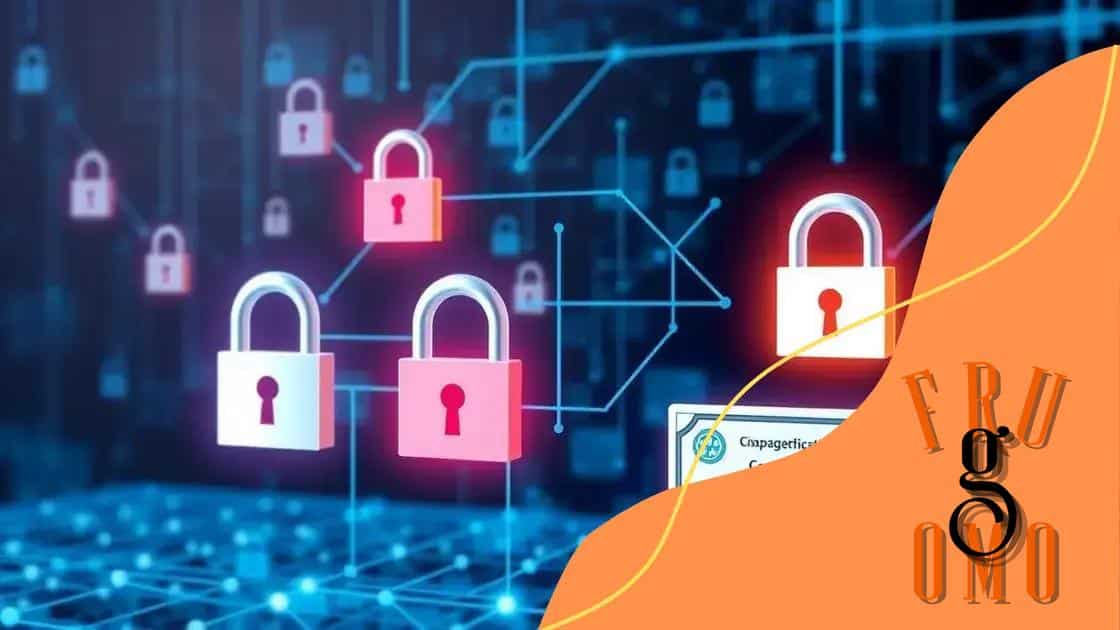Blockchain for academic credentialing: a game changer

Blockchain for academic credentialing enhances security, transparency, and efficiency by providing a decentralized system for verifying and managing credentials, preventing fraud and empowering students in their educational achievements.
Blockchain for academic credentialing is changing how we validate educational achievements. Have you ever considered how secure your academic records are? This technology promises a new level of trust and efficiency.
Understanding blockchain technology
Understanding blockchain technology is key to grasping its impact on many sectors today. Imagine a digital ledger that is not only secure but also transparent. This is exactly what blockchain offers, allowing data to be recorded in a decentralized manner.
What is blockchain?
At its core, blockchain is a collection of records organized in a way that makes them secure and immutable. Each record, known as a block, is linked to previous records, forming a chain. This design prevents tampering and ensures trust among users. With blockchain, every transaction is visible to everyone on the network, making it very difficult for bad actors to commit fraud.
Key features of blockchain technology
- Decentralization: Without a central authority, control is distributed among all participants.
- Transparency: Everyone can see the transactions, enhancing accountability.
- Security: Advanced cryptography keeps data safe and secure.
- Immutability: Once recorded, the data in a block cannot be easily changed.
These features contribute to the growing popularity of blockchain across industries. For instance, in finance, it revolutionizes how transactions occur without intermediaries. In healthcare, it allows for secure sharing of patient records. This potential for various applications explains why businesses are eager to adopt it.
As organizations explore blockchain technology, they find innovative ways to use it. From supply chain management to voting systems, the possibilities seem endless. It’s captivating how a technology initially designed for cryptocurrency is transforming entire systems.
The importance of credentialing in education
Credentialing in education plays a vital role in ensuring that institutions maintain high standards. It helps create trust between students, employers, and educational providers. This process ensures that qualifications are authentic and that graduates possess the required skills and knowledge.
Why is credentialing significant?
One major reason for the importance of credentialing is that it verifies the educational achievements of individuals. This verification process gives employers confidence when selecting candidates for jobs. Without proper credentialing, it would be difficult to assess whether a person has the necessary abilities.
Benefits of effective credentialing
- Enhances trust: Students and employers can rely on the validity of academic programs.
- Improves employment opportunities: Credentialed individuals often have a better chance of being hired.
- Supports educational integrity: Ensures institutions uphold quality standards.
- Facilitates continual learning: Encourages individuals to seek further education and skills.
As education systems evolve, credentialing becomes crucial for keeping pace with changes in job requirements. Employers often demand proof of qualifications that align with today’s rapidly changing job market. Thus, educational institutions must adapt their credentialing practices.
Furthermore, with technological advancements, credentialing processes are becoming more sophisticated. Blockchain technology is emerging as a game changer in this area, helping to create secure digital records of credentials. This not only enhances trust but also simplifies verification processes.
How blockchain enhances security of credentials

Blockchain technology significantly enhances the security of credentials in various ways. By using a decentralized system, it eliminates the need for a central authority, which reduces the risk of fraud. Each credential is stored as a unique block in a chain, making it extremely difficult to alter any information without detection.
How does blockchain improve credential security?
One of the main benefits is the use of cryptography. Each block is encrypted, ensuring that only authorized users can access the data. This means that academic records and professional credentials cannot be easily tampered with. Furthermore, every transaction involving credentials is recorded in a transparent manner, so all parties can verify authenticity.
Key advantages of using blockchain for credentials
- Immutability: Once recorded, credentials cannot be changed or deleted without leaving a trace.
- Transparency: All stakeholders can view the same data, fostering confidence and trust.
- Access control: Only those with permission can update or add information, ensuring secure management.
- Cost-effectiveness: Reduces administrative burdens associated with verifying and issuing credentials.
Moreover, the integration of smart contracts allows for automated processes in credential verification. This means that once a credential is issued, it can be verified in real-time without manual intervention. This streamlines recruitment processes, saving time for both employers and candidates.
As institutions adopt blockchain for credentialing, they create a more secure environment for sharing educational achievements. This not only benefits graduates looking for jobs but also employers seeking trustworthy candidates.
Case studies of blockchain in academia
Case studies of blockchain in academia showcase how this technology is transforming the educational landscape. Many universities are exploring innovative ways to manage records and streamline processes. Through these examples, we can see the real-world applications and benefits of blockchain.
University of Melbourne
The University of Melbourne implemented a blockchain-based system to issue diplomas. This allows graduates to have secure, verifiable credentials that employers can easily access. By using blockchain, they ensure that there is no possibility of forgery, enhancing the integrity of their degrees.
MIT Media Lab
Another impressive case is the MIT Media Lab, which developed the Digital Diploma project. This initiative uses blockchain to create and store digital diplomas securely. Students can share these digital diplomas with employers or other educational institutions effortlessly. This initiative highlights how blockchain simplifies the process of credential sharing.
Open University
The Open University in the UK also leverages blockchain technology to store student achievements. They collaborate with other institutions to create a network of trusted credentials. By Doing this, students can accumulate and share their learning pathways securely and transparently.
Benefits of these case studies
- Enhanced security: Reduces the chances of diploma fraud.
- Ease of access: Graduates can easily share their credentials.
- Greater trust: Employers can verify credentials quickly.
- Innovative collaboration: Institutions work together to improve the academic credentialing process.
Through these case studies, it is clear that blockchain technology is paving the way for more secure and efficient credentialing processes in academia. These advancements not only benefit institutions but also empower students and employers alike.
Future trends in credentialing and blockchain
Future trends in credentialing and blockchain suggest a significant evolution in how educational credentials are managed and verified. As technology continues to progress, the integration of blockchain in education and professional environments is expected to grow.
Decentralized education systems
One major trend is the move towards decentralized education systems. Traditional institutions may face competition from new educational platforms that utilize blockchain. These decentralized systems can offer flexible learning opportunities and empower learners to control their own credentials.
Greater emphasis on lifelong learning
The importance of lifelong learning is gaining traction. As job markets evolve, individuals will need to upskill continuously. Blockchain technology facilitates this by securely tracking ongoing learning achievements. This means that every course or workshop completed can be added to a student’s verified record.
Enhanced interoperability
Another key trend is enhanced interoperability among different credentialing systems. As institutions adopt blockchain, they will be able to share information more easily. This will allow for better collaboration across educational institutions, companies, and professional organizations.
Personalized learning pathways
- Customization: Students will be able to tailor their learning experiences.
- Ownership: Learners will own their credentials, allowing them to share them on their terms.
- Verification: Employers will have real-time access to verified skills and qualifications.
- Flexible credentials: Non-traditional education paths will become more recognized.
The trend towards using artificial intelligence in conjunction with blockchain is also noteworthy. As AI systems become more advanced, they can help assess and recommend learning paths. This will create a more adaptive and personalized educational experience.
In conclusion, blockchain technology is changing the way we think about credentialing in education. By enhancing security and trust, blockchain makes it easier for students to manage their achievements. As more institutions adopt this technology, we can expect greater transparency and efficiency in how credentials are issued and verified. This innovation not only benefits students and employers but also creates a more adaptable and personalized learning environment. As we look to the future, the trends indicate a shift toward a more connected and collaborative educational ecosystem powered by blockchain.
FAQ – Frequently Asked Questions about Blockchain in Academic Credentialing
What is blockchain technology?
Blockchain is a decentralized digital ledger that securely records transactions across multiple computers, ensuring that records cannot be changed retroactively.
How does blockchain enhance the security of credentials?
Blockchain enhances security by preventing unauthorized access and fraud, as each credential is stored in an encrypted format that is linked to others, making tampering difficult.
What are the benefits of using blockchain in education?
Benefits include increased trust in credentialing, easier verification for employers, and the ability for students to control and share their achievements securely.
Will blockchain replace traditional educational institutions?
Blockchain is more likely to complement traditional institutions by providing new ways to manage credentials and enhance accessibility in education rather than replacing them.





